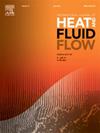利用游动喷流控制崖体尾流
IF 2.6
3区 工程技术
Q2 ENGINEERING, MECHANICAL
International Journal of Heat and Fluid Flow
Pub Date : 2024-11-01
DOI:10.1016/j.ijheatfluidflow.2024.109605
引用次数: 0
摘要
本研究对 ReD∼2⋅105 时轴对称崖体后方的尾流进行了研究,并通过四种类型的行进射流进行了控制,这些射流由在基底边缘附近进行行进运动的不同射流剖面组成。对这些喷流和非强制尾流进行了比较。采用平均速度、压力场、湍流动能和光谱正交分解(SPOD)来描述流内的相干结构。我们的研究证实了主导模式的存在,并将先前的研究结果扩展到了与流向平行和垂直的几个平面上的速度场和压力场。如 SPOD 所示,这些模式代表了尾流的大量能量,因此是行进中的喷气机减少阻力的主要目标。为了实现压力恢复,已经提出并研究了几种类型的激励器:基线游动喷流的阻力降低率最高,压力恢复率为 +62%,其次是振荡游动喷流,压力恢复率为 +34%,脉冲游动喷流为 +32%;相反,横扫游动喷流会显著增加阻力,基础压力降低率为 -460%。以基线流动射流为重点,压力恢复是通过抑制主导模式、减少夹带以及拉长和缩小尾流等综合措施实现的。本文章由计算机程序翻译,如有差异,请以英文原文为准。
Control of a bluff body wake using travelling jets
This work investigates the wake behind an axisymmetric bluff body at and applies control via four types of travelling jets which consist of different jet profiles undergoing travelling motion near the base edge. A comparison between these and the unforced wake is presented. Mean velocity, pressure fields, turbulence kinetic energy, and spectral proper orthogonal decomposition (SPOD) are employed to characterise the coherent structures within the flow. Our investigation confirms the presence of dominant modes and extends the previous findings to the velocity and pressure field on several planes parallel and perpendicular to the streamwise direction. These modes, as shown by SPOD, represent the wake’s bulk energy and therefore are the main target for travelling jets to pursue drag reduction. In the interest of achieving pressure recovery, several types of actuators have been proposed and investigated: the baseline travelling jet obtains the highest drag reduction with a pressure recovery of , which is followed by the oscillatory travelling jet with and the pulsed travelling jet with ; conversely, the sweeping travelling jet dramatically increases the drag with a reduction in base pressure. Focusing on the baseline travelling jet, pressure recovery is achieved via a combination of dominant modes suppression, entrainment reduction, and wake’s elongation and narrowing.
求助全文
通过发布文献求助,成功后即可免费获取论文全文。
去求助
来源期刊

International Journal of Heat and Fluid Flow
工程技术-工程:机械
CiteScore
5.00
自引率
7.70%
发文量
131
审稿时长
33 days
期刊介绍:
The International Journal of Heat and Fluid Flow welcomes high-quality original contributions on experimental, computational, and physical aspects of convective heat transfer and fluid dynamics relevant to engineering or the environment, including multiphase and microscale flows.
Papers reporting the application of these disciplines to design and development, with emphasis on new technological fields, are also welcomed. Some of these new fields include microscale electronic and mechanical systems; medical and biological systems; and thermal and flow control in both the internal and external environment.
 求助内容:
求助内容: 应助结果提醒方式:
应助结果提醒方式:


